Learn why biblical tales of fish dying offer timeless lessons on environmental care and human impact, urging us to act now.

Fish Dying in the Bible
Like a river that suddenly runs dry, the biblical narratives involving fish dying are more than mere stories; they're a reflection of deeper truths and warnings.
You've probably heard of the Plague of Blood, where the Nile turned to blood, killing all fish within it, but that's just the tip of the iceberg. From Ezekiel's prophecies to the apocalyptic visions in Revelation, these events carry profound implications for environmental stewardship and the consequences of human actions.
As you explore these ancient texts, you'll uncover a tapestry of lessons that are as relevant today as they were thousands of years ago. Why do these stories matter now, you ask? Let's find out together.
Key Takeaways
- Dying fish in biblical prophecies symbolize ecological and spiritual decay.
- These events prompt reflection on modern environmental management and stewardship.
- Symbolism serves as a warning for the urgent adoption of sustainable practices.
- Biblical lessons underscore the importance of collective environmental responsibility.
The Plague of Blood
One of the earliest recorded mass fish die-offs, the Plague of Blood, dramatically transformed the Nile's waters into blood, decimating the aquatic life within. This event, steeped in historical and religious significance, offers a profound example of environmental catastrophe and its immediate consequences on biodiversity. The Nile transformation wasn't just a physical alteration of water's color and composition, but a pivotal moment that underscored the fragility of aquatic ecosystems.
Analyzing the aquatic consequences of this transformation reveals a multifaceted disaster. First, the sudden change in water quality likely led to a significant drop in oxygen levels, a condition known as hypoxia. Fish, unable to survive in these conditions, perished en masse. Additionally, the alteration of the Nile's ecosystem would have disrupted the food chain, affecting not only fish but also other organisms reliant on the river for sustenance.
This narrative serves as a critical case study in understanding the interconnectivity of natural water bodies and the life forms they support. It emphasizes the catastrophic impact human actions or divine interventions can have on aquatic ecosystems, highlighting the need for stewardship and conservation of these vital resources.
The Prophecy of Ezekiel
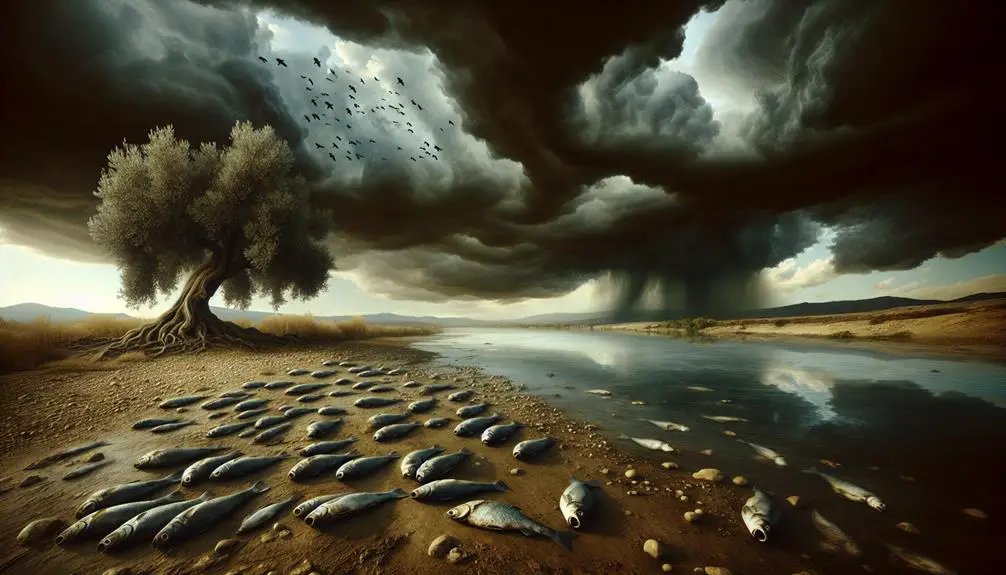
You'll find that Ezekiel's vision, as outlined in the Bible, provides a profound narrative on ecological and spiritual decay, resonating with contemporary concerns about environmental degradation.
This segment will explore the symbolism behind the dying fish in Ezekiel's prophecy and its implications for today's world.
Ezekiel's Vision Explained
In the heart of the Old Testament, Ezekiel's vision stands as a profound prophecy, offering deep insights into the nature of divine judgment and restoration. Through divine imagery and visionary symbolism, this narrative captures the essence of spiritual renewal and the consequences of collective disobedience.
You're invited to explore the layers of meaning behind the creatures with multiple faces, the wheels within wheels, and the expansive, radiant figure above them. These elements aren't just fantastical imagery; they symbolize the omnipresence and omniscience of the divine, the complexity of God's plans, and the intense purity of divine glory.
Ezekiel's vision, rich in metaphor and meaning, serves as a bridge between human understanding and divine intention, emphasizing that redemption and judgment are woven intricately into the fabric of spiritual existence.
Implications for Modern Times
Exploring Ezekiel's vision further, consider how its themes of divine judgment and restoration hold profound relevance for contemporary society. In the face of climate change, his prophecies resonate with urgent calls for humanity to acknowledge its role in environmental degradation and to embark on concerted conservation efforts. This isn't just about spiritual redemption but also about practical, earthly survival.
Here are three key ways Ezekiel's message is crucial today:
- Climate Action: His warnings underscore the necessity for aggressive action against climate change.
- Conservation Efforts: They highlight the importance of preserving our natural resources, including water bodies and marine life.
- Global Responsibility: Ezekiel's vision encourages a collective, global response to environmental crises, emphasizing that restoration is possible with concerted effort and moral responsibility.
The Vision of Zephaniah
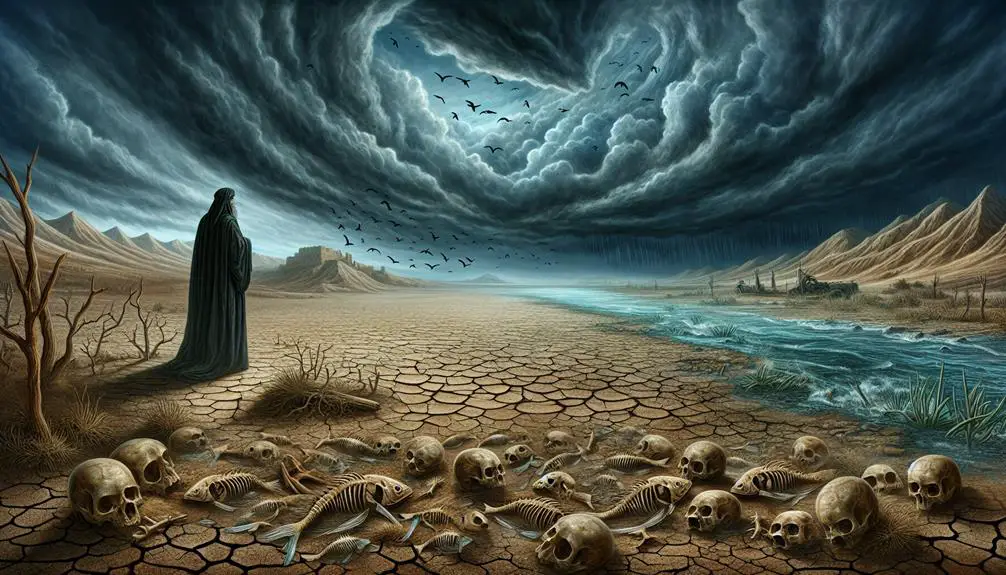
Analyzing the vision of Zephaniah, we uncover a profound message about environmental degradation that resonates with contemporary concerns. Within Zephaniah's context, the prophet operates during a time of considerable social and religious reform in Judah, reflecting a period fraught with moral and ecological recklessness. His apocalyptic imagery, vivid and unsettling, serves not merely as a forewarning of divine wrath but as a mirror to our own era's environmental crises.
Zephaniah's visions highlight the interconnectedness of human sinfulness and the degradation of the natural world, a linkage that's strikingly relevant today. He speaks of a sweeping judgment that won't only affect humanity but also the fish of the sea, signaling an indiscriminate ecological catastrophe. This inclusion of fish dying as part of the divine judgment underscores the totality of environmental collapse, emphasizing that no aspect of creation is immune from the repercussions of human folly.
In this, Zephaniah's prophetic messages urge a reconsideration of our relationship with the natural world. They beckon us to acknowledge the depth of our impact on the planet's health and to recognize the moral imperative of environmental stewardship. Through his ancient words, we're reminded of the enduring truth that our actions have consequences, not just for ourselves but for all living beings.
Hosea's Dire Prediction
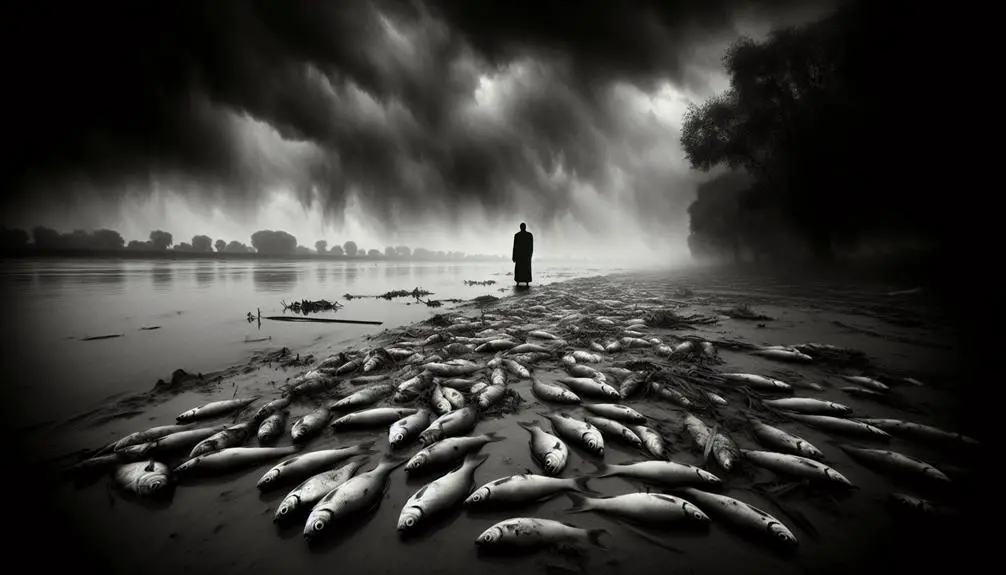
Delving into Hosea's prophecy, you encounter a bleak forecast that, much like Zephaniah's, links humanity's spiritual decay directly with environmental devastation. Hosea vividly illustrates the consequences of Israel's transgressions, emphasizing the interconnectedness of societal ethics and ecological health. This ancient narrative underscores the intrinsic relationship between spiritual malaise and the natural world's deterioration.
Hosea's prediction doesn't just serve as a religious admonition; it also offers a profound insight into the environmental consequences of ancient agriculture and societal impacts. Consider the following:
- Land degradation: Ancient agricultural practices, without sustainability, led to soil depletion and reduced fertility, echoing Hosea's warnings of a barren land.
- Water scarcity: Overuse and mismanagement of water resources in agricultural activities could have led to the droughts and water shortages Hosea describes, affecting both human and aquatic life.
- Biodiversity loss: The prophecy of dying fish symbolizes the broader ecological collapse, likely exacerbated by human exploitation of natural resources.
In this context, Hosea's dire prediction transcends its historical setting, offering timeless lessons on the consequences of ignoring the symbiotic relationship between human activity and environmental health.
The End Times in Revelation

Turning our attention to the Book of Revelation, we encounter vivid depictions of the end times, where environmental catastrophes play a central role in the unfolding eschatological narrative. This scripture, often shrouded in mystery and rich in symbolism, invites you to delve deeper into its layers, revealing insights about the fate of the world and its inhabitants.
As you peer through Heaven's gates, the narrative unfurls with the arrival of the Apocalyptic horsemen, signaling the onset of a series of divine judgments.
These horsemen, each symbolizing different aspects of the end times—conquest, war, famine, and death—usher in a period marked by unparalleled turmoil. The environmental imagery employed is stark, painting a picture of a world teetering on the brink of collapse. Yet, it's not just about the calamity; it's a call to reflection, urging you to consider the moral and spiritual implications of humanity's stewardship of the earth.
The text, while foreboding, serves as a reminder of the transitory nature of the present world and the impermanence of human constructs in the face of divine will. It challenges you to look beyond the immediate, to question, and to seek understanding in the midst of chaos.
Droughts and Their Impacts
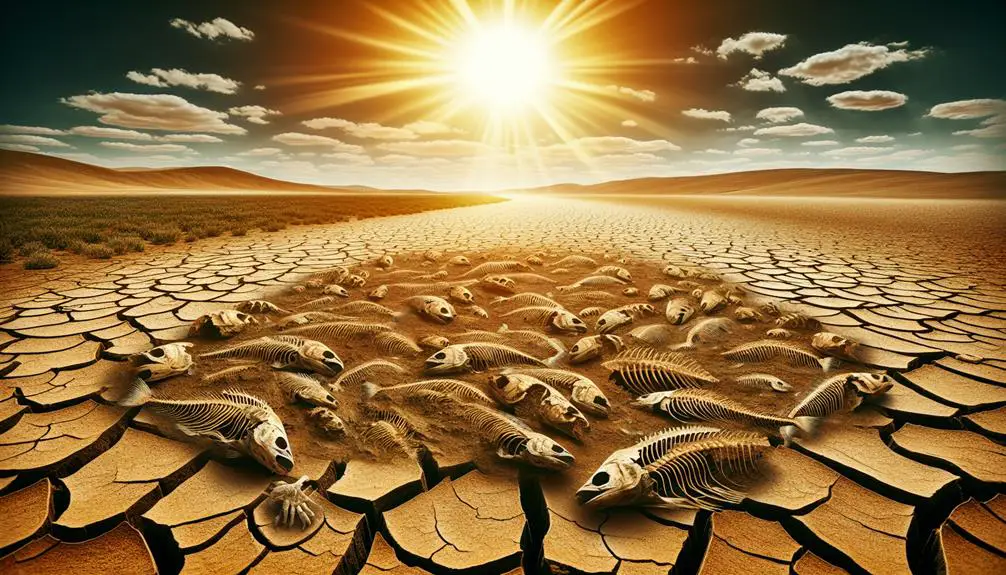
Amidst the myriad of environmental crises prophesied in the Bible, droughts stand out for their profound impact on both the land and its people, stripping away the very essence of sustenance and life. These periods of prolonged dryness don't just affect the immediate availability of water but also lead to a cascade of ecological and societal challenges.
In the realm of biblical narratives, droughts serve as a metaphor for spiritual barrenness and a call to repentance, but in today's context, they underscore the critical necessity for sustainable practices. Water conservation and climate adaptation strategies are pivotal in mitigating the impacts of droughts. Here are three key approaches:
- Implementing efficient irrigation techniques to minimize water use in agriculture.
- Enhancing water storage capacities to ensure availability during dry spells.
- Promoting drought-resistant crops to secure food supplies despite water scarcity.
These strategies not only align with contemporary efforts towards climate adaptation but also reflect a deeper understanding of stewardship of the Earth's resources. In analyzing the biblical precedence of droughts, you're reminded of the urgency to adopt water conservation measures and to adapt to changing climates, ensuring the resilience of communities and ecosystems against the challenges of drought.
Pollution of Holy Waters
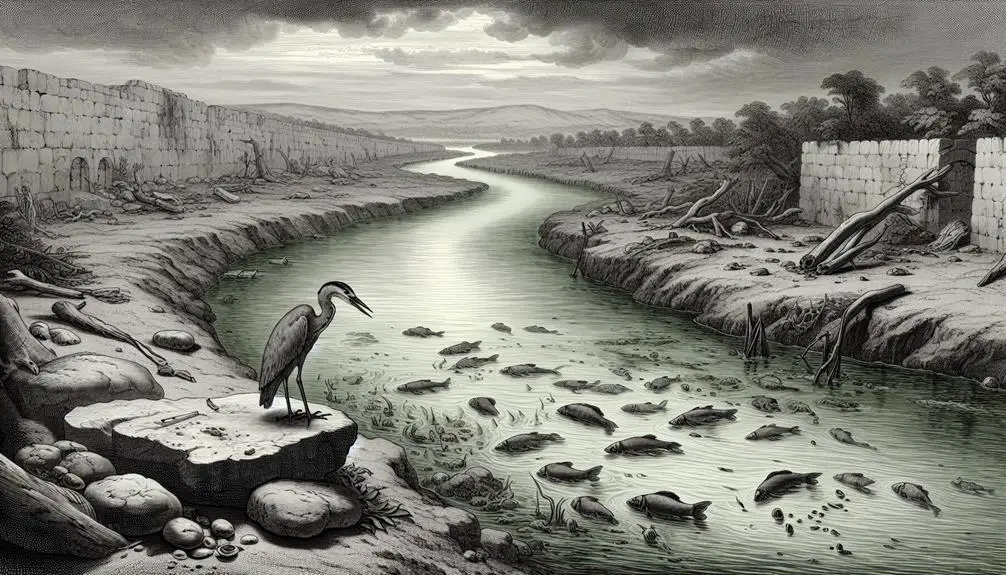
While droughts underscore the scarcity of water, the pollution of holy waters reveals the complexities of human impact on sacred and natural resources. You're entering a realm where reverence for nature and the consequences of human activities collide, affecting both water quality and aquatic ecosystems in profound ways. The degradation of these waters isn't just an environmental issue; it's a spiritual and cultural crisis that challenges the very essence of how societies value and interact with the natural world.
The pollution of holy waters is multifaceted. It involves not only the direct dumping of waste but also the less visible, insidious seepage of pollutants from urban and agricultural runoff. These activities compromise water quality, threatening the health of aquatic ecosystems that are often considered sacred. The ramifications are far-reaching, affecting not just the biodiversity within these waters but also the spiritual practices and rituals that depend on them.
Understanding the pollution of these waters requires an acknowledgment of the interconnectedness of human actions and environmental health. It's a call to reflect on the broader implications of how societies live, consume, and dispose of their resources, impacting not just the present but also future generations' access to these sacred natural resources.
Lessons for Modern Stewardship
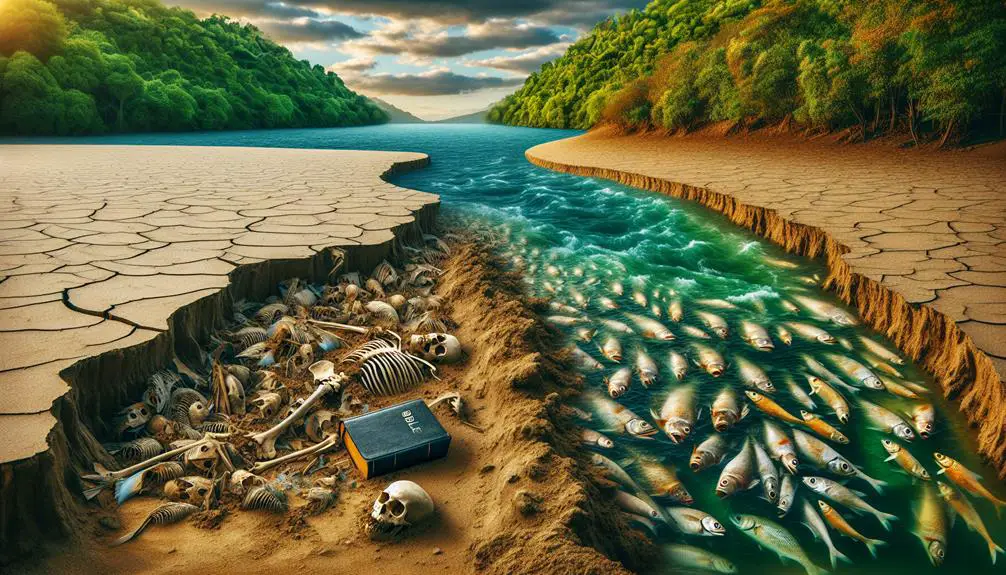
You might find that reflecting on Biblical stewardship offers a poignant perspective on modern environmental responsibilities. By examining historical lessons on the repercussions of neglect and disrespect towards nature, you're encouraged to reassess your role in preserving the planet.
This insight not only deepens your understanding of ancient texts but also highlights the urgency of adopting sustainable practices today.
Reflecting on Biblical Stewardship
The concept of stewardship, deeply embedded in biblical narratives, offers critical lessons for contemporary environmental management and conservation efforts. You're called to reflect on how ancient wisdom can guide modern actions, especially in areas of climate action and the development of a green theology. This stewardship isn't just about preservation but involves active participation in healing the earth.
Here are the key lessons for modern stewardship:
- Responsibility: You're entrusted with the care of creation, not just for yourself but for future generations.
- Sustainability: Your actions should support the long-term health and balance of ecosystems.
- Community: Collective action is crucial. It's not just an individual responsibility but a shared duty.
These principles, rooted in ancient texts, are incredibly relevant today, encouraging a thoughtful and proactive approach to environmental challenges.
Modern Environmental Responsibilities
In today's rapidly changing environment, it's crucial that individuals understand their roles and responsibilities in fostering a sustainable future, drawing on the lessons of biblical stewardship as a guiding framework. This involves actively combating climate change and investing in renewable energy.
You're called to be stewards of the earth, a duty that extends beyond mere conservation to proactive engagement. By reducing your carbon footprint and supporting policies that prioritize the planet's health, you're honoring this ancient directive.
Transitioning to renewable energy sources isn't just a practical move against climate change—it's a moral imperative. Embracing these responsibilities, you not only safeguard the environment but also uphold the stewardship principles envisioned in biblical times, ensuring a livable world for future generations.
Learning From Historical Lessons
Historical lessons offer invaluable insights for modern stewardship, demonstrating how past practices can inform and refine today's environmental strategies. When you examine ancient agriculture and historical mining, you're not just looking at old techniques; you're uncovering patterns of interaction with the natural world that have had lasting impacts. These insights are critical for developing sustainable practices.
Consider the following:
- Ancient agriculture teaches us about crop rotation and soil preservation.
- Historical mining reveals the consequences of unchecked resource extraction.
- Both fields offer lessons in the balance between human activity and environmental sustainability.
Frequently Asked Questions
How Did Ancient Cultures Other Than Those in the Bible Interpret Mass Fish Die-Offs, and Are There Any Parallels or Common Themes?
Exploring how ancient cultures interpreted mass fish die-offs, you'll find a rich tapestry of ancient symbolism and cultural rituals. These events weren't just ecological anomalies; they were often seen as omens or messages from the gods.
Whether it was a call to repent, a sign of impending disaster, or a prompt for ritualistic responses, parallels across cultures suggest a common theme of seeing the natural world as deeply interconnected with the divine.
What Are the Scientific Explanations or Natural Phenomena That Could Account for the Biblical Descriptions of Fish Dying?
Exploring the causes of mass fish deaths, you'll find that algal blooms play a significant role, leading to oxygen depletion in bodies of water. Imagine, 90% of such die-offs can be attributed to these phenomena.
Algal blooms, essentially a rapid increase in algae, consume the oxygen fish need to survive, suffocating them. This scientific explanation offers a natural perspective on events that might otherwise seem extraordinary or unexplainable.
In What Ways Have Modern Environmentalists and Scientists Used These Biblical Stories to Advocate for Water Conservation and Against Pollution?
You've seen scientists and environmentalists draw from historical narratives to highlight the urgency of water conservation and the fight against pollution. By delving into scriptural analysis, they uncover theological implications that resonate with modern environmental concerns.
This scholarly approach not only contextualizes ancient stories within today's ecological crisis but also leverages them as powerful tools to advocate for the preservation of our planet's precious water resources and the life they sustain.
Are There Any Recorded Instances in History Where a Significant Fish Die-Off Was Seen as a Fulfillment of Biblical Prophecy Outside of the Contexts Mentioned?
You're diving into whether history has documented significant fish die-offs as prophecy validation. While there's a wealth of historical documentation, pinpointing these events as direct fulfillments of biblical prophecy, outside previously discussed contexts, proves challenging.
Scholars and environmentalists have often interpreted natural disasters through a biblical lens, yet concrete connections between specific die-offs and prophecies require careful analysis, blending scientific inquiry with theological interpretation.
How Do Contemporary Religious Leaders and Communities Interpret These Biblical Events in the Context of Current Environmental Challenges?
When you explore how contemporary religious leaders and communities view environmental challenges, you'll find that theological interpretations often emphasize ecological stewardship. They see the care for the environment as a divine mandate, connecting current ecological crises with broader spiritual responsibilities.
This perspective not only underscores a commitment to preserving the planet but also reiterates the importance of interpreting ancient texts in ways that speak to today's pressing environmental issues.
Conclusion
In scrutinizing the biblical narratives on fish perishing, from the Plague of Blood to the apocalyptic visions in Revelation, it's evident that these tales serve as potent metaphors for environmental stewardship. They underscore the dire consequences of neglecting our duty to protect natural resources.
By analyzing these ancient texts, we're reminded that the sustainability of aquatic life is intricately linked to human actions. Thus, these stories not only reflect historical or prophetic events but also impart crucial lessons on ecological responsibility for contemporary society.

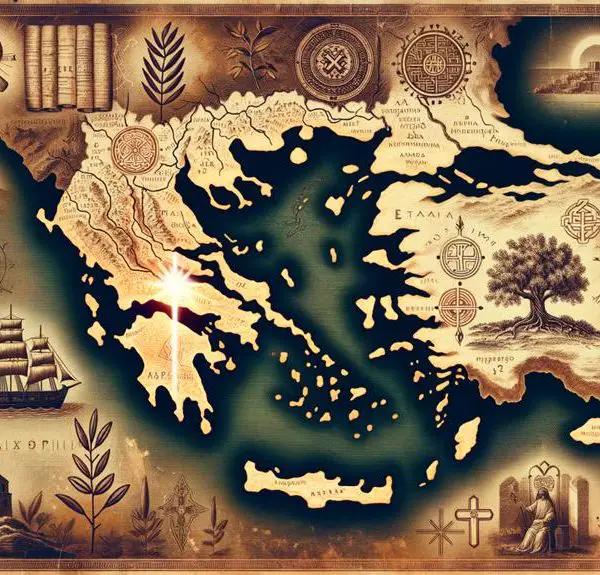
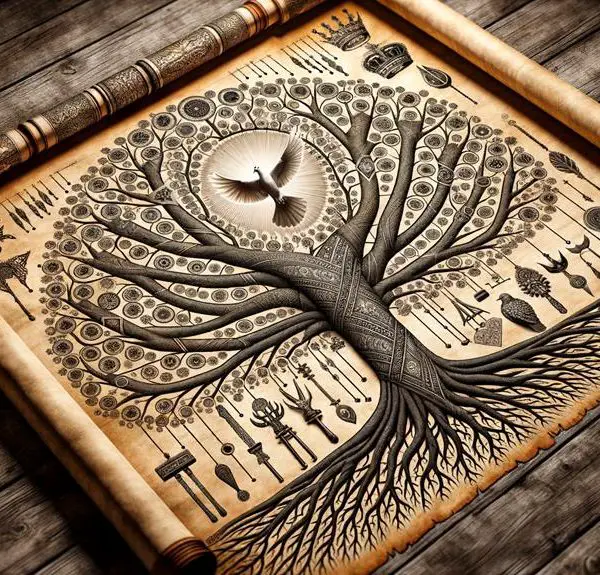
Sign up